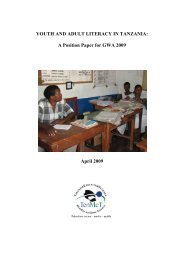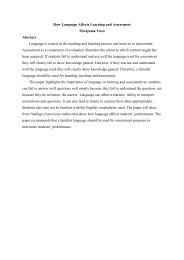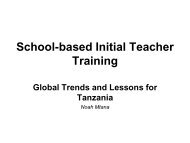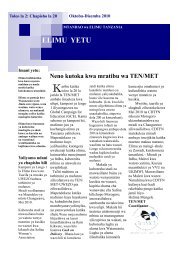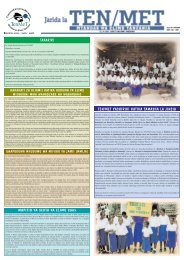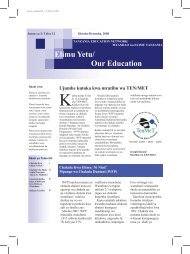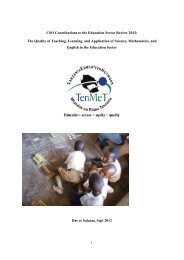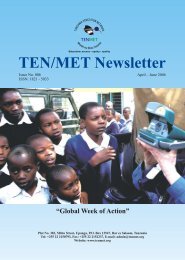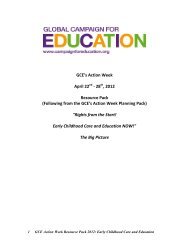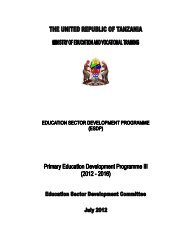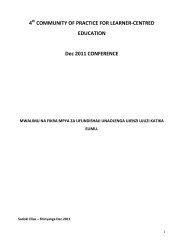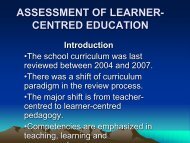Status of Children in Tanzania - 2012 - Tanzania Education Network ...
Status of Children in Tanzania - 2012 - Tanzania Education Network ...
Status of Children in Tanzania - 2012 - Tanzania Education Network ...
Create successful ePaper yourself
Turn your PDF publications into a flip-book with our unique Google optimized e-Paper software.
Total<br />
Urban<br />
Rural<br />
Call for Action<br />
<strong>Tanzania</strong> experience reveals that there is worst form <strong>of</strong> child labour practiced <strong>in</strong> m<strong>in</strong><strong>in</strong>g areas like<br />
Mererani, Arusha where children are be<strong>in</strong>g sent dip <strong>in</strong>to underground m<strong>in</strong><strong>in</strong>g popularly labelled as<br />
„nyoka‟ because <strong>of</strong> their flexibility. The same practice is also witnessed at Makongolosi Chunya –<br />
Mbeya where children are sent <strong>in</strong>to dip pit to dig soil for gold extraction. In fish<strong>in</strong>g areas like<br />
Kigoma, children are also socked <strong>in</strong>to deep lake waters to put fishnet for catch<strong>in</strong>g sard<strong>in</strong>es. In this<br />
endeavour sometimes children lose their life and no protection <strong>of</strong> whatever is provided<br />
In Mwanza, Kigoma and Dar es Salam children are work<strong>in</strong>g <strong>in</strong> highly exploitative urban employment<br />
like fish<strong>in</strong>g and fish<strong>in</strong>g process. Studies <strong>of</strong> ILO <strong>in</strong> <strong>Tanzania</strong> estimate that child labour <strong>in</strong> fish<strong>in</strong>g<br />
<strong>in</strong>dustry is 23%. Major child labour activities <strong>in</strong>cludes scale fish, wash and fuel boats, mend fish<strong>in</strong>g<br />
nets, process and load fish. Experience <strong>of</strong> Mwanza, Dar es Salaam, and Kigoma revealed that<br />
children are perform<strong>in</strong>g these work on boats, beaches. In that ve<strong>in</strong> children are be<strong>in</strong>g exposed to<br />
hot sun, harsh weather, <strong>of</strong>ten work<strong>in</strong>g for long hours <strong>in</strong> dirty and unhygienic environment, littered<br />
with fish waste products and <strong>in</strong>fested with flies, that <strong>in</strong>creases risk <strong>of</strong> contract<strong>in</strong>g diarrhea <strong>in</strong>fections<br />
and other illness<br />
As noted <strong>in</strong> <strong>2012</strong> child labour such as commercial sex work, domestic child labour, and labour <strong>in</strong><br />
tobacco plantation have been found to have a direct connection with child traffick<strong>in</strong>g. A study<br />
conducted by International Organization for Migration (IOM) 2008 and 2009 revealed that <strong>in</strong><br />
<strong>Tanzania</strong> there is <strong>in</strong>ternal and cross border child traffick<strong>in</strong>g. The study further revealed that child<br />
foster<strong>in</strong>g is <strong>of</strong>ten utilized as a cover for child traffick<strong>in</strong>g. Majority <strong>of</strong> traffick<strong>in</strong>g victims are children,<br />
Ir<strong>in</strong>ga is lead<strong>in</strong>g 15%, Morogoro 9%, Kilimanjaro 9%, and S<strong>in</strong>gida 8%. F<strong>in</strong>d<strong>in</strong>gs revealed that<br />
recruiters <strong>of</strong> child traffick<strong>in</strong>g entice parents and child with promises <strong>of</strong> education or work prospects.<br />
At the dest<strong>in</strong>ation children are exploited by the trafficker, sale the child and subject the child to<br />
<strong>in</strong>timidation, abuse and exploitation. Evidence from Kilimanjaro and Arusha demonstrates that<br />
sometimes traffick<strong>in</strong>g victims are turned <strong>in</strong>to traffickers. The trafficked youth have been sent back to<br />
their villages to recruit new children to work <strong>in</strong> the tanzanite m<strong>in</strong>es <strong>in</strong> Mererani. Similarly young<br />
girls may be sent back to their home village to recruit younger girls <strong>in</strong>to sex bus<strong>in</strong>ess. The bus<strong>in</strong>ess<br />
is contrary to human right and sometimes such practice can make a girl child contract HIV/AIDS.<br />
Child labour <strong>in</strong> <strong>Tanzania</strong> expose children to different types <strong>of</strong> hazards, such as dusts, fumes, and<br />
gases <strong>in</strong> their work<strong>in</strong>g environment, children aged between 7 – 13, and 5 – 6 years are subjected to<br />
heat high temperature and humidity. Other types <strong>of</strong> hazards mentioned by children <strong>in</strong>cludes<br />
<strong>in</strong>sufficient lighten<strong>in</strong>g, work<strong>in</strong>g up hill/greater heights, work<strong>in</strong>g underground, noise, dangerous tools,<br />
snake bites and animals. All these hazards threat growth, survival and development <strong>of</strong> children.<br />
The f<strong>in</strong>d<strong>in</strong>gs revealed that child labour affects attendance <strong>of</strong> children at school; sometimes it is<br />
causal factor for dropout or failure to complete the cycle <strong>of</strong> primary education. (K<strong>in</strong>dly observe table<br />
5 which follows for more observations).<br />
Table 5: Households by <strong>in</strong>volvement <strong>of</strong> <strong>Children</strong> <strong>in</strong> work<br />
Area <strong>Children</strong> <strong>in</strong>volvement Ma<strong>in</strong>land Zanzibar <strong>Tanzania</strong><br />
HH % HH % HH %<br />
No children 2,064,104 34.6 37,551 29.2 2,101,655 34.5<br />
At least one child <strong>in</strong> economic 3,259,922 54.7 48,223 37.5 3,308,145 54.3<br />
work<br />
At least one child <strong>in</strong><br />
318,119 5.3 38,431 29.9 356,550 5.9<br />
housekeep<strong>in</strong>g only<br />
No work<strong>in</strong>g children 319,415 5.4 4,382 3.4 323,796 5.3<br />
Total 5,961,560 100.0 128,586 100.0 6,090,147 100.0<br />
No children 1,117,768 46.1 29,712 34.7 1,147,480 45.7<br />
At least one child <strong>in</strong> economic 847,337 34.9 18,998 22.2 866,335 34.5<br />
work<br />
At least one child <strong>in</strong><br />
269,181 11.1 35,041 41.0 304,223 12.1<br />
housekeep<strong>in</strong>g only<br />
No work<strong>in</strong>g children 192,243 7.9 1,763 2.1 194,006 7.7<br />
Total 2,426,530 100.0 85,514 100.0 2,512,044 100.0<br />
No children 3,181,872 37.9 67,263 31.4 3,249,135 37.8<br />
At least one child <strong>in</strong> economic 4,107,259 49.0 67,221 31.4 4,174,480 48.5<br />
work<br />
At least one child <strong>in</strong><br />
587,301 7.0 73,472 34.3 660,773 7.7<br />
housekeep<strong>in</strong>g only<br />
No work<strong>in</strong>g children 511,658 6.1 6,145 2.9 517,803 6.0<br />
Total 8,388,090 100.0 214,101 100.0 8,602,190 100.0<br />
SOURCE: Research f<strong>in</strong>d<strong>in</strong>gs <strong>2012</strong><br />
14 / 55 <strong>Tanzania</strong>-CRSA-REPORT-<strong>2012</strong><br />
A lov<strong>in</strong>g home for every child




